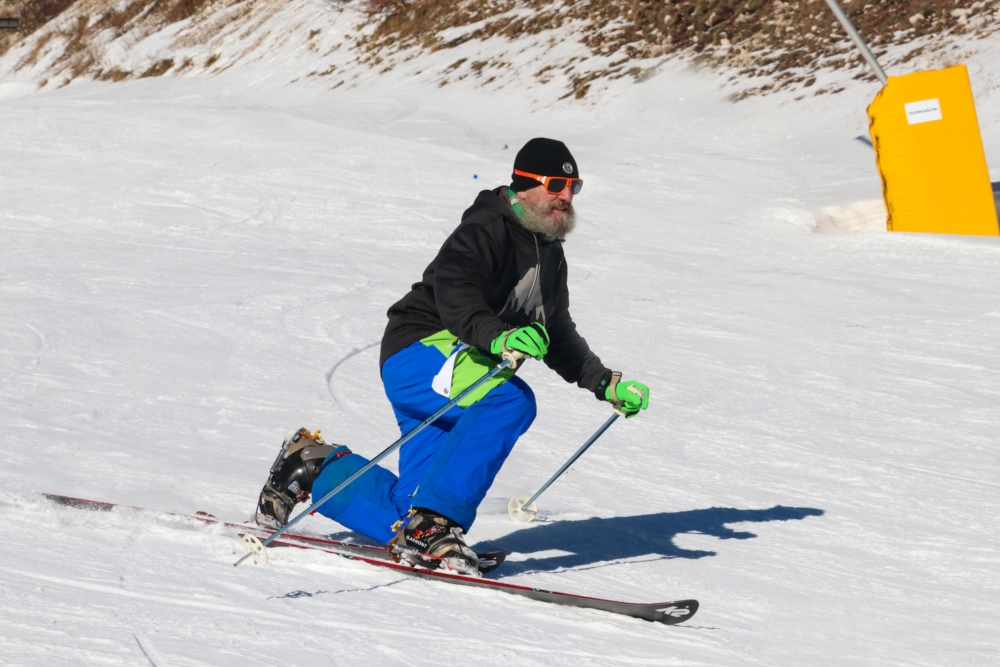Types of Ski Boots


There are four major types of ski boots:
- Alpine ski boots (also known as downhill ski boots)
- Alpine touring ski boots
- Telemark ski boots
- Cross-country ski boots
Check out our guide to different types of skis.

Alpine Ski Boots
Alpine ski boots, also called downhill ski boots, are designed to have a snug fit and are optimized to efficiently transfer a skier’s intent and power to the ski for optimal performance on downhill slopes.
This type of ski boot is designed for ski resorts and getting access to ski trails via ski lifts, or very short treks. When properly fit, it will work to seamlessly and comfortably transfer power from the skier to the skis. It’s crucial to ensure alpine ski boots fit properly. If they don’t, you’ll likely experience discomfort.
Alpine ski boots are composed of a rigid plastic shell with adjustable buckles, allowing a secure and precise fit. Inside the shell, a padded inner liner provides comfort and insulation. The boots’ soles are designed to integrate with alpine ski bindings, which lock the heel into the binding. This secures the ski boot to the ski but will release the boot during falls to prevent injuries.

Alpine Touring Ski Boots
Alpine touring ski boots are designed for both downhill skiing and backcountry skiing. They look similar to alpine boots since they are also made of rigid plastic. But unlike traditional downhill boots, they feature a walk mode and require special ski bindings, allowing the heel to lift for easier hiking movement.
Touring offers the unique thrill of skiing through untouched powder and provides access to challenging and unique terrains. Touring boots require special bindings that free the heel for traversing without completely unlocking it from the ski, offering versatility for backcountry adventures. The boots are made from lighter materials to reduce effort while hiking.
While touring boots will not perform as well for downhill skiing as high-end alpine boots, their lightweight and versatile design makes them ideal for tackling different types of terrains, and varying snow depths.

Telemark Ski Boots
Telemark ski boots are specifically designed for telemark skiing, which combines elements of alpine and Nordic skiing. To accommodate the needs of this technique, telemark ski boots provide a unique combination of flexibility and support.
Telemark skiing is known for its unique technique where one knee drops toward the ski during turns, providing a physical challenge and a rhythmic sense of flow. Enthusiasts of this style often appreciate the fluid turns it offers. Additionally, telemark skis are versatile, allowing skiers to hike and explore backcountry areas, opening up new terrains for skiing.
Modern telemark boots have a rigid plastic shell and a taller cuff with buckles, similar to alpine and touring boots, although they often have an instep buckle to lock the heel in place when skiing. They feature a bendable section at the front, called the bellows, that helps the skier make the carving turns for which telemark skiing is known. The bindings, either the traditional 75mm (3-pin) or the modern New Telemark Norm (NTN) system, are unique because they only attach the boot at the toe, allowing the heel to lift freely during turns.

Cross-Country Ski Boots
Cross-country ski boots are used for Nordic, or cross-country, skiing, which is done on flat or rolling landscapes and requires a gliding motion. To achieve the technique, only the ski boot tips are to be secured to the ski, allowing the heels to lift and the foot to flex and power the skier forward.
Cross-country ski boots are made from soft fabric and are more comfortable than rigid alpine ski boots. They typically only feature a zipper or sometimes also an upper cuff strap to secure and tighten the boot to the foot.
There are four different types of cross-country ski boots:
Classic Ski Boots: Designed for traditional cross-country skiing on groomed trails, these boots are generally flexible and comfortable. They offer good ankle support while flexing the foot naturally during the striding motion.
Skate Ski Boots: Used for skate skiing, a technique resembling ice skating, these boots have stiffer soles and more ankle support compared to classic boots, providing a better power transfer for the side-to-side skating motion.
Combi Boots: Combi boots offer a balance between the flexibility needed for classic skiing and the ankle support required for skate skiing, making them a good option for anyone who practices both techniques.
Backcountry Ski Boots: Backcountry boots have a sturdier build for off-trail and rugged terrain. This means they provide more support and warmth and are often compatible with heavier-duty bindings to handle variable snow conditions.
Cross-country ski boots require special skis and ski bindings. There are a variety of ski binding types, and they are not compatible across the different types of cross-country ski boots.




